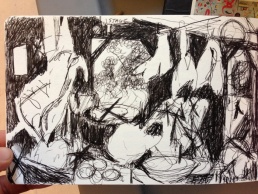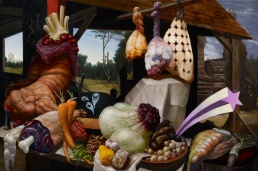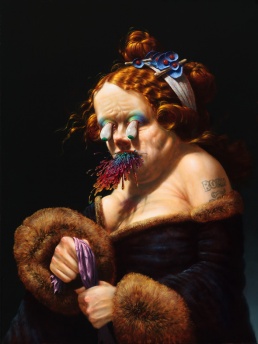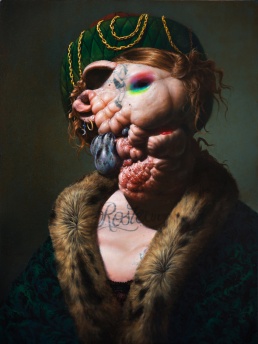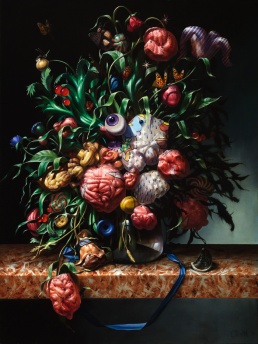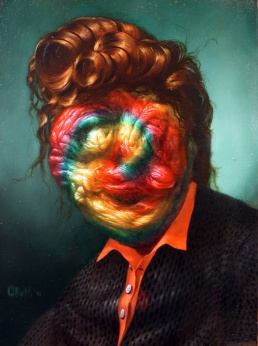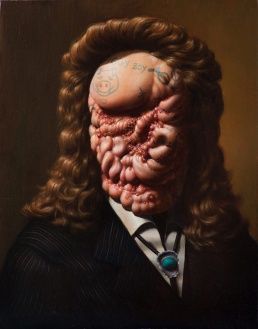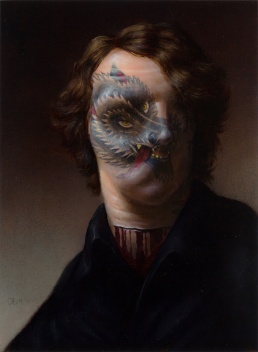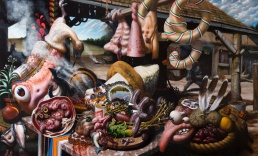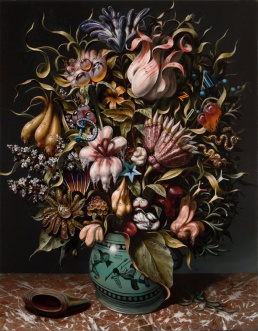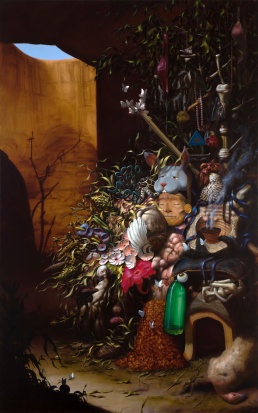This is Christian Rex Van Minnen
Art that comes with a challenge, for me, is good art. This is art which sets into light questions instead of obvious answers. This type of art triggers a contemplative reaction and stirs intrigue within, forcing one to exercise critical thinking. It’s substantial.
Christian Van Minnen’s art is definitely the type which challenges the audience. In Christian Van Minnen’s world, things are mutated, displaced and distorted. His subjects are often turned into lumps of various ambiguous organic matters resembling anything from pieces of meat and sea shells. Flesh, plant life and other random elements are fused together morphing into new entities oozing with weird liquids and possibilities. All these Van Minnen executes in a superb Renaissance style of painting. Through this classical approach the artist is able to tweak the grotesque into vibrant, eerily beautiful artworks. Due to the contrasting nature of subject and technique, Van Minnen’s paintings challenge one’s notion of what is beautiful.
But there is more (of course). Like I said challenging art is substantial. Below is an interview with the artist where we discussed his concepts, his history and views which are all distilled and seep into his art. Read on and find out a little more about this amazing artist and his creations.
THIS IS CHRISTIAN REX VAN MINNEN.
Interview by Crist Espiritu.
Artworks by Christian Rex Van Minnen.
Did you get into art at a young age? When did you start showing signs of creativity? Tell us about your beginning.
Definitely. I was drawing at a very early age. I remember drawing imaginary animals with the short pencils and small pieces of paper stored on the back of the church pews. I was really drawn to field guides and spent a lot of time in nature. I think that was really important.
Where are you from? Would you say that your environment affected your development as an artist?
I was born in Rhode Island. I remember spending a lot of time in the woods or on the beaches and tide pools. My uncles were fishermen and had a fish market in Charlestown RI called Rathbones. I remember seeing all sorts of strange things they would drag in, like sharks and once a huge, already dead, leatherback sea turtle. I distinctly remember seeing its spiked esophagus. My parents were completely supportive of everything I did and never judgmental.
Did you go to art school?
No. I went to Regis University, a small Jesuit liberal arts college in Denver, CO, where I received a BA with and emphasis in art and later a Master’s of Nonprofit Management. The Jesuit education is a great thing; very well-rounded and rigorous with an emphasis on service.
“I am attracted to grotesque, colorful, spectacular, and technically ambitious work that is more emotional than intellectual.”
Who were the artists you look up to when you were growing up? Who are your favorite artists now? Why do you like their art?
I think my first favorites were comic book artists like Todd McFarlane. Around that same time I discovered HR Giger via the Aliens movie. After that I discovered the artists of the early surrealist movement. I have so many favorite artists nowadays: Nicole Duennebier, Ryan Riss, Judy Pfaff, Jenny Morgan, Barnaby Furnas, Skinner, Erik Parker, Judy Fox, Kenny Scharf, Ryan Schneider, Amir Fallah, Martin Wittfooth, Gregory Jacobsen, Sinisa Kukec, Liz Craft, Wayne White, Ryan Travis Christian, Seamus Conley, Fulvio di Piazza, Mark Dean Veca, Tomoe Gokita, Robin Williams, Barnaby Whitfield, Julie Heffernan, Nicola Verlato, David Altmejd, Robert Hardgrave, Kim Keever, Aaron Johnson, Brendan Danielsson, Wangechi Mutu… jeez, so many, I could go on and on. I am attracted to grotesque, colorful, spectacular, and technically ambitious work that is more emotional than intellectual.
Tell us how you arrived on your current paintings style. Did you ever dabble in different styles of painting? What about other medium? Why did you deem this style as the best one to visually translate your ideas?
The way I work now is an evolution of automatic drawing, which I’ve done for a very long time. I had a great High School art teacher, Tish McFee, who introduced me to oils when I was 15 and I took to it right away and started doing it on my own. I haven’t really worked with many other types of media. I used to make a lot of papier-mâché masks and for a time I was designing products with used building materials and construction waste because I had a job in a junk yard. My work ‘works’ for me, you know? I want to see things that are both real-looking and abstract and sort of difficult to swallow. I make pictures that satisfy that desire.
What’s behind your fascination with the macabre?
The ‘macabre’ is subjective. I don’t consider my work that ‘macabre’.
“I want to see things that are both real-looking and abstract and sort of difficult to swallow. I make pictures that satisfy that desire.”
Your paintings have a very strong shock effect. Why is shocking the audience important?
It’s not. It satisfies something in me. Maybe that’s shocking. I need to connect with difficult emotions to engage in a sort of cathartic event, to become more free.
Why are people portrayed very darkly in your paintings? Is this a reflection of how you see humans/ society?
These aren’t necessarily characters, or ‘people’ as you suggest. I see the figures more as piles than people. Essentially, I am engaging in automatism and abstraction within the context of conventional portraiture. Not so much an investigation into societal issues as they are meditations on the nameless, personal, abstract and emotional.
“I resist being didactic with my work. Things are just things. Sometimes things like caricatured hearts, stars, rainbows, diamonds, etc, have found their way into the work but only as objects and shapes that serve as compositional contrasts to other ‘things’ in the paintings.”
There are usually a lot of elements in your paintings. Where do you usually draw these images from? Are they from personal memories or are they put there to have precise visual metaphors?
No metaphors. I resist being didactic with my work. Things are just things. Sometimes things like caricatured hearts, stars, rainbows, diamonds, etc, have found their way into the work but only as objects and shapes that serve as compositional contrasts to other ‘things’ in the paintings. All of these things come into play from initial abstract brush work in the underpaintings. Don’t look to deconstruct my paintings as if they were riddles. They are meant to remain ambiguous.
Tell us about your piece “The Great Western Buffet”. What is this all about? This piece reminds me of Peter Aertse’s “Butcher’s Stall with the Flight into Egypt” . Can you tell us a bit about this parallelism? Why did you choose this particular piece? Why did you feel the need to sort of “redo” it?
“Great Western Buffet’ 2012, and an earlier work, “Marketplace”, 2010, are both interpretations on Aertsen’s “Butcher Stall”. I was fascinated by the painting for its distinct stylistic conventions and division of space. Like Rembrandt’s portraits, or de Heem’s or Mignon’s still-lifes, I often refer to compositions developed in the Renaissance and Dutch Golden Age as these periods were the apex of the master-composition. What I am interested in there is the compositional geometry and method of delivering visual information to achieve narrative or meaning. I use these works as stylistic restraints to play within, allowing abstraction to develop its own form, significance and ambiguous narrative. It re-contextualizes something old and didactic into something more mysterious, ambiguous and open to interpretation; something more appropriate for the age we live in.
Do you have any upcoming project you’d like to share to our readers?
Not really. Just gallery shows. I just make paintings, slowly and surely. You can keep up with shows and stuff on Facebook or on my blog –> christianvanminnen.blogspot.com
“I had to work a myriad of shitty full-time jobs for 10 years while also painting full-time before I could quit and just paint. It was grueling but there was no other choice. You really have to want to do it, regardless of success.”
What makes a good artist? What trait should someone who wants to make it as artist posses? Do you have any advice for young creative types out there who wants to get into art?
I don’t know. There are a lot of ways to do this. I think talent and hard work are important in becoming a successful. My favorite artists do this for themselves because they find deep personal meaning in the process. That shows in the work, and I think, that makes them successful. I had to work a myriad of shitty full-time jobs for 10 years while also painting full-time before I could quit and just paint. It was grueling but there was no other choice. You really have to want to do it, regardless of success.
What drives you to keep on making art? What pushes you forward in your artistic development?
I like what I see! Oil painting has this beautiful quality of giving back what you put into it. It’s simple and yet infinitely mysterious. I am so pleased that an audience for my work has grown.
Follow Christian Rex Van Minnen on Instagram @van_minnen
Follow Crist Espiritu on Twitter and Instagram @crist_espiritu
